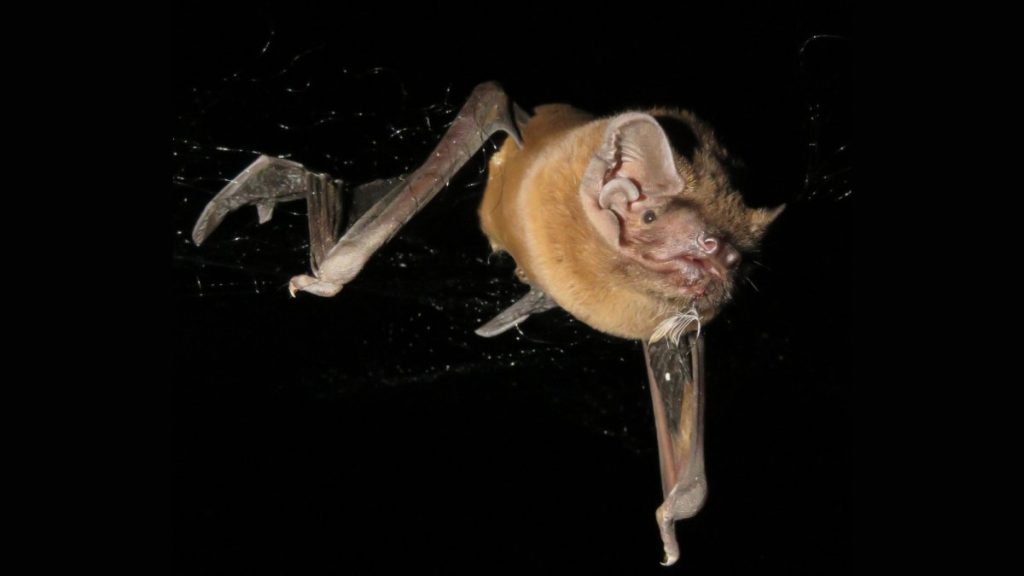It’s hard to think of a spookier wildlife scenario: A songbird is flying through the air, when it’s suddenly intercepted from above at breakneck speed by a large, fanged bat. After a brief struggle, the attacker disappears into the gloom with its bloody prey in tow. But for over two decades, biologists have suspected that these events are even darker than that scary situation. And thanks to tiny bat “backpacks,” experts have now confirmed their nightmarish theory. According to a study recently published in the journal Nature, the greater noctule (Nyctalus lasiopterus) doesn’t only kill its next meal midair—it also dismembers and devours it without landing.
One big bat
In Europe, bats don’t get any bigger than the greater noctule. Conservationists have described the species and its 18-inch wingspan as “unmistakable due to its size.” It’s also one of the only bats known to feast on small birds. Beyond this, however, not much is known about the increasingly rare creatures. The ICUN Red List currently considers the animal “threatened,” a status that will likely grow more dire due to ongoing deforestation.
Carlos Ibáñez at the Doñana Biological Station in Seville, Spain, has spent his entire career studying the noctule. He and colleagues first discovered feathers in the bats’ droppings nearly 25 years ago, leading them to believe the species is one of the few that catches and eats birds.
“We knew that the greater noctule catches and eats insects in flight, so we assumed it did the same with birds–but we needed to prove it,” he said in a statement.
But even after installing artificial “smart” roosts, implanting microchips in the bats, and logging thousands of hours of data, Ibáñez’s team couldn’t confirm their theory. Meanwhile, others in their field doubted the hypothesis, since many bird species weigh as much as half as much as a greater noctule. After years of work and a collaboration with researchers at Denmark’s Aarhus University, the team has finally proven the bird-eating-bat believers correct.
If you give a bat a backpack…
The solution came in the form of lightweight backpacks for the greater noctules. Each backpack is stuffed with an array of small biological instruments that record the winged mammal’s acceleration, altitude, movement, and vocalizations including a bat’s echolocation pings. After capturing a pair of wild noctule bats and attaching the harmless packs, the researchers released them back into the world and waited for them to get hungry. It didn’t take long for the team to learn the answer to their longstanding question–-andI it’s not exactly for the faint of heart.
Both of the bats followed a general pattern of attack. First, the predators spotted a bird below them, while stalking the skies over half a mile above the ground. They then nosedived while beating their wings faster to triple their acceleration speed. During the assault, the bats emitted a steady stream of attack calls.
While some bugs have evolved the ability to detect these comparatively low-frequency ultrasound triangulations, birds have not. Despite this, one of the bats abandoned its pursuit after 30 seconds, with the study authors reminding readers that birds are at least as agile as their hunters.
“We know that songbirds perform wild evasive maneuvers such as loops and spirals to escape predators like hawks during the day–and they seem to use the same tactics against bats at night,” said Ibáñez.
However, the other noctule spent almost three minutes chasing its target before catching it close to the ground. What researchers heard next amounted to a horror story—a total of 21 distress calls from the captured bird, followed by 23 minutes of “chewing sounds” as the bat continued to fly at a low altitude. The evidence on the ground beneath showed the grisly encounter further illustrated the macabre meal: the severed wings of a songbird.
Fly, catch, kill, eat, repeat
According to the team, it appears that the noctules kill their prey by biting them before gnawing off their limbs to reduce weight and drag. To eat, the bats likely then stretch the membranes between their hind legs forward to form a pouch, then devour their catch while on-the-go.
“It’s fascinating that bats are not only able to catch them, but also to kill and eat them while flying,” study co-author Laura Stidsholt noted. “A bird like that weighs about half as much as the bat itself–it would be like me catching and eating a 35-kilo [77-pound] animal while jogging.”
As the first test subject showed, bats aren’t always successful. But what counts is that some of them are, and that makes the greater noctules even more special. The discovery also highlights the importance of continued conservation work. With this new information, ecologists can now develop better and more effective wildlife management strategies.
“While it evokes empathy for the prey, it is part of nature. We knew we had documented something extraordinary,” said Tena. “For the team, it confirmed what we had been seeking for so long. I had to listen to it several times to fully grasp what we had recorded.”


